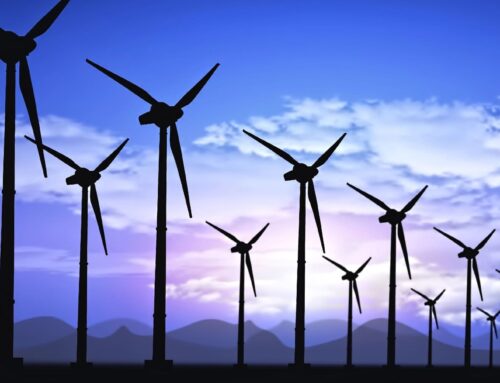Colorado utilities & rural electric co-ops double down on climate goals, even in hostile p
October 9, 2025
The Trump administration has signaled its preference for fossil fuels, and in some cases, an outright hostility to renewable energy.
The One Big Beautiful Bill Act clawed back millions of dollars in tax credits for solar and wind, and the administration has also added permitting barriers for renewables on public lands. That’s not stopping both large utilities and rural electric co-ops in Colorado from continuing to pursue their clean energy goals.
That persistence was the topic of conversation during a panel discussion at the Mountain Towns 2030 Climate Summit, which took place in Breckenridge, Colorado, from October 7-8. The panel, titled “The Reality of 100% Renewable Generation,” was moderated by John Creyts, CEO of Rocky Mountain Institute.
The panelists represented the two sides of electricity providers in Colorado: rural electric co-ops, including CEO Bryan Hannegan of Holy Cross Energy and CEO Chris Hansen of La Plata Electric, and large multi-state utilities, including Andrew Holder of Xcel Energy and Duane Highley of Tri-State Generation and Transmission Association.
Each panelist discussed the ways their respective utility companies have worked to create more renewable energy sources like wind, solar, and hydropower in their portfolios.
Xcel, which operates across eight states, has a goal of being 80% carbon-free by 2030, and 100% carbon-free by 2050. Holder said that some of its wind projects under development in the Eastern Plains are some of the largest in the country, and will be huge in helping the utility meet that goal.
“As we look towards the 2030 mark, we are projecting to be 88% (carbon-free),” he said. “Some of our folks in regulatory might kick me, but we’re projecting that we might be closer to 93% as we get to the end of this decade.”
Despite its name, Tri-State actually operates in four states: Colorado, Wyoming, New Mexico, and Nebraska.
“Since 2019, we have been making a very rapid transition on our part of the grid,” said Highley. “So we went from a majority coal-based system to today, we’re 50% clean energy: wind, hydro and solar. And by the end of this decade, just a few years away, we’ll be at 70% clean energy across all four states.”
La Plata Electric, which operates in southwest Colorado, has a goal of reducing its carbon footprint by 50% from 2018 levels by year 2030. Part of its goal is to keep its members’ electricity costs lower than 70% of other co-ops in the state.
Hansen discussed some of the projects that La Plata has been pursuing in order to meet its goals.
“We’ve just set a contract with local hydro for a long-term 10 year contract,” he said, adding that investing in battery storage has also been a smart move for the co-op. “In our system we’ve got about 25 megawatts of rooftop, which is in the context of a 160-megawatt system. So that is a great running start to getting ourselves to a hundred percent clean. And then we’re adding grid-scale projects and community solar gardens and batteries along with that at the substation level.”
Holy Cross, a rural electric co-op that serves Eagle, Pitkin, and Garfield counties on Colorado’s Western Slope, had the most aggressive renewable energy goal on the panel: 100% clean energy by 2030. So far, it’s on track to meet that goal. In May of 2025, 96% of energy delivered to its members came from renewables.
Hannegan told audience members that in October 2025, averaging across all nine months so far, 87% of that energy was coming from wind, solar, and hydro associated with battery storage. He attributed that success to a five-part plan that starts with basic energy efficiency at the individual home level.
“You want to solve a problem, make it smaller, so get more energy services out of everything that you use,” he said.
The next steps involve the co-op’s wholesale power supply to renewable sources, its partnerships with local communities on generating electricity locally, members generating their own power through rooftop solar, and rebates for electrification.
Hansen said mountain towns are often dealing with a very unique mix of clients, especially with rural-resort economies playing key roles.
“We have Purgatory Ski Resort, down to the individual home in the middle of Durango,” he said. “Trying to figure out what works best for that member, maximize their efficiency, get rid of demand charges, all the things that we’re trying to do to provide value for our members and reduce emissions along the way: that is, I think, the path forward.”
Hansen and Hannegan discussed some of the ways that—as smaller players in the game—they can achieve their goals without raising costs for consumers. That looks like a blend of sources: power purchase agreements from the bigger utilities like Xcel and Tri-State, their own infrastructure projects like wind and solar, and members generating their own energy via rooftop solar that the co-op buys from them.
“We’re going to try to be the conductor and bring the symphony together, but we’re going to be looking for investment from lots of different pockets,” Hansen said.
Panelists also discussed some of the difficulties of pursuing renewable energy in the current political climate.
Hannegan said Holy Cross’ service area is incredibly diverse, spanning from the traditionally bluer counties of Pitkin and Eagle to the typically more conservative Garfield County. He said that people care most of all about electricity being reliable, safe, and affordable.
“And I think if you do those three things and you do them extremely well, then you earn the social license to start talking about, ‘can we do it in a cleaner and more sustainable way?’” he said. “Not just with respect to climate change, but with air, water, land, resources: you know, building infrastructure disturbs the environment around us. That conversation is much easier to have if it is rooted in the facts and information.”
Hannegan concluded the panel with a call to action for all of the MT2030 attendees: help us out.
“We are taking care of electricity, one-third of the carbon economy,” he said, referencing the utilities. “The transportation, the buildings, the commercial, the industrial: that’s up to you and your elected leaders. We need a commensurate effort on that side of the climate challenge to match what we, in the state of Colorado, are really making progress on, on the electricity side.”
Copyright 2025 Rocky Mountain Community Radio. This story was shared via Rocky Mountain Community Radio, a network of public media stations in Colorado, Wyoming, Utah, and New Mexico, including Aspen Public Radio.
Search
RECENT PRESS RELEASES
Related Post



